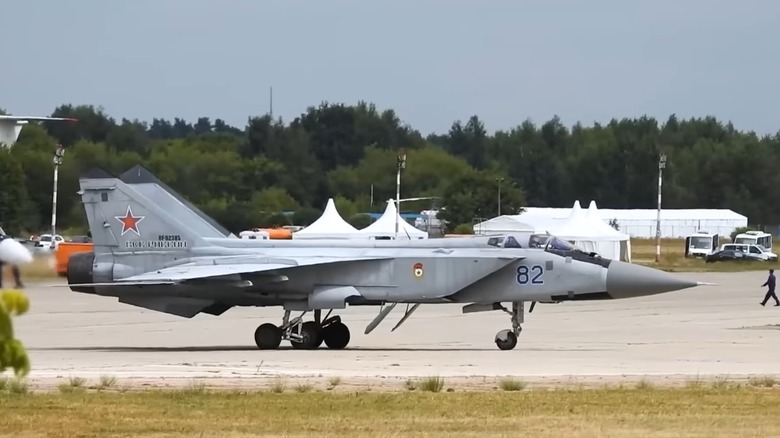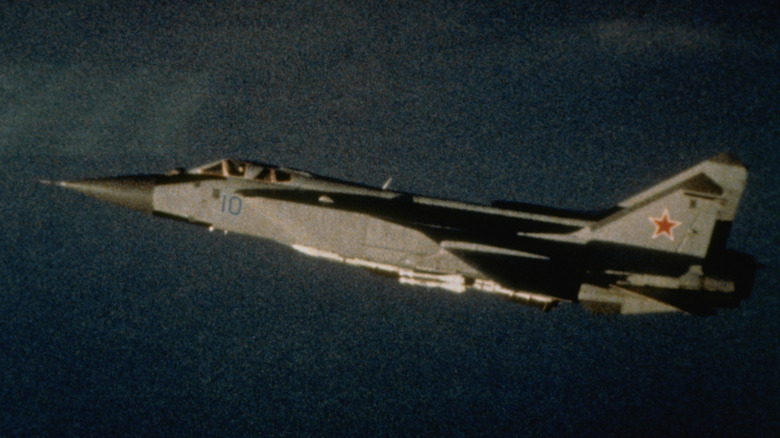What Is The Difference Between The MiG-25 Foxbat Vs. MiG-31 Foxhound Fighter Jets?
Both the MiG-25 and MiG-31 are Cold War-era tools designed to be lightning-fast interceptors with the MiG-25 also capable of reconnaissance. The USSR wanted to keep its secrets and couldn't afford to have US aircraft gathering intelligence. The Soviets also wanted a countermeasure in case Western nations ever decided to launch bombers toward their borders. Starting its service in 1970, what made the MiG-25 Foxbat jet so terrifying was that it shattered records. This Russian interceptor could achieve a top speed of Mach 2.8 and broke 29 records involving altitude and climbing rate, among others.
The MiG-25 Foxbat proved to be a competent interceptor, but concerns in the Soviet Union were rising over the successful use of the Lockheed SR-71 Blackbird by the US Air Force. With two Pratt & Whitney J58 engines producing 32,500 pounds of thrust each, the Blackbird was flying unopposed over Soviet skies. In 1979, the MiG-31 (Foxhound) stepped forward as a Foxbat replacement (although the Foxbat continued to operate into the Gulf War with the Iraq military) and offered some compelling enhancements, such as more robust engines, better technology, and more weapons.
The Foxbat could hit serious speeds, but with a few significant caveats
While the MiG-25 Foxbat features two Tumansky R-15B-300 turbojet engines capable of around 22,500 pounds of thrust each, it has a few drawbacks. The Foxbat could achieve incredible velocity well over twice the speed of sound (Mach 2.8 for sustained flights). Some reports state the Foxbat could reach upwards of Mach 3 or higher for brief periods, but not without drastically reducing its engines' lifespan. Considering military aircraft aren't cheap, the USSR didn't want to prematurely burn out the powerplants of their interceptors well before replacements were ready.
Another issue with the Foxbat was that it couldn't reach supersonic speeds closer to the ground. The turbojet engines on the MiG-25 couldn't overcome the greater air density at lower altitudes limiting its capabilities. The MiG-31 Foxhound could hit Mach 1.23 much closer to the ground, outperforming the Foxbat. The Foxhound came equipped with two Solovyev D-30F6 turbofan engines that, despite featuring a low-bypass ratio for enhanced efficiency, guzzled fuel at higher rates than other aircraft due to its multiple roles.
Enhanced radar, and multi-role armaments
The MiG-25 offered a potent radar system of its time, but the MiG-31 far outpaces it. In fact, the MiG-31 was the first of its kind with an electrically scanned N007 Zaslon phased array radar. With more robust radar technology, the MiG-31 can keep an eye on upwards of 10 objects at the same time and as far away as 124 miles. The MiG-31 also has 12 variants that each offer specific advantages. For example, the MiG-31M comes equipped with liquid-crystal multifunctional displays and a more robust computer system. The MiG-31D was customized to counter satellite weapons, and features a unique radar system that points up. The MiG-31A has been involved with ushering tourists into space in conjunction with a rocket-powered suborbital glider, although commercial space travel is expensive.
The MiG-25 Foxbat had up to four air-to-air missiles at its disposal, two radar-guided AA-6 and two R-40T that were infrared-guided weapons. The MiG-31 Foxhound can accommodate more weapons, incorporating both air-to-air and air-to-surface variants, making it a greater threat to the enemy. With four short range-missiles, two medium-range missiles, and a six-barrel 30mm internal cannon, the Foxhound could function effectively in a wide range of engagements. But, the Foxhound can't execute sharp turns; instead, it tracks and eliminates targets quickly from a distance, then retreats, making it a poor dogfighter. Regardless, the Foxhound is still one of the best fighter jets developed during the Cold War.


